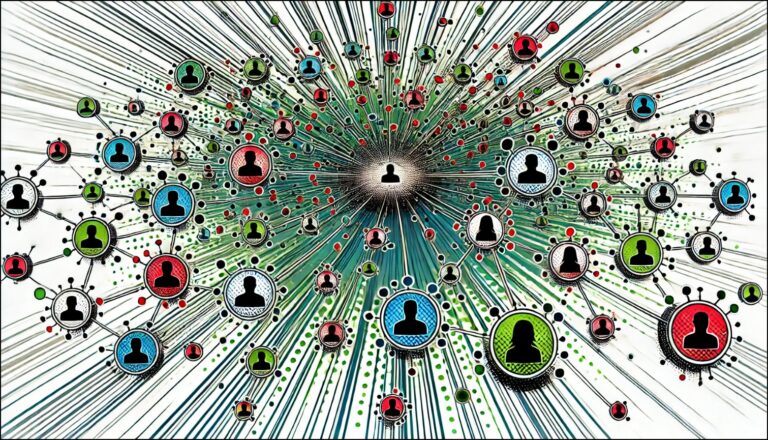Following the murder of UnitedHealthcare’s CEO, social media discourse raged with misinformation, fake news, and conspiracy theories about the murder, alongside violent threats targeting CEOs of other major healthcare insurance companies. Here’s what Cyabra uncovered:
TL;DR?
- Fake profiles in the discourse: 15% of violent and threatening posts were created by bots, that used hashtags like #CEOAssassin, #DenyDefendDepose, and #TheClaimsAdjustor to amplify their messages and reach more eyes.
- Three false narratives went viral after the murder, spreading misinformation, conspiracies, and fake news:
- Brian Thompson’s murderer was linked to the Illuminati and Deep State
- Thompson’s grieving wife was accused of being involved in her husband’s murder
- Politician Nancy Pelosi was accused of orchestrating the murder
- The conspiracies, spread mostly by authentic profiles, reached a total of over 483 million potential views
The Illuminati, Deep State, and Nancy Pelosi
Brian Thompson, the CEO of UnitedHealthcare, was shot and killed on December 4, 2024, in Midtown Manhattan. The assailant, 26-year-old Luigi Mangione, was apprehended days later in Pennsylvania and is facing charges of murder and terrorism.
Cyabra’s analysis of social media discourse surrounding Thompson’s death has uncovered a surge of fake news and conspiracy theories surrounding the murder, as well as extremism and violent threats against other healthcare companies’ CEOs.
Misleading and false narratives about the murder started spreading online minutes after it was reported. Those conspiracies were mainly spread by authentic profiles.
Three narratives were the most prominent in the conversation:
1. Thompson’s Murderer Connected to the Illuminati & Deep State
Cyabra’s analysis uncovered 344 authentic profiles that spread 406 posts and comments across Facebook and X referencing the Illuminati and Deep State in connection with the case. Many of the posts allege that these entities were directly involved in the crime. This narrative received 3,657 engagements and reached a potential 3.2 million views.
2. Thompson’s Wife Was Involved in the Murder
Another conspiracy theory identified by Cyabra accused Brian Thompson’s grieving wife of involvement in his murder. Hundreds of authentic accounts have circulated claims that the couple was undergoing a divorce or experiencing relationship issues, suggesting a possible motive. Others referenced an interview Thompson’s wife gave shortly after his death, in which she supposedly “did not appear visibly distressed”, which further fueled speculation about her involvement. Below are two posts that supported this conspiracy, one gaining over 770,000 views, and the other over 270,000 views. X influencer Zackrichland claimed that Thompson’s wife participating in the interview was a “red flag”, suggesting that she was attempting to shift the narrative by claiming Thompson received multiple threats against him, thereby diverting suspicion away from herself.
3. Nancy Pelosi Was Involved in the Murder
A prominent and controversial narrative that has gained significant traction online alleges that Nancy Pelosi was involved in the murder of Brian Thompson. The narrative claimed that Thompson was set to testify against Pelosi in an insider trading case the following week, suggesting that his murder was a deliberate attempt to silence him. This conspiracy theory has been widely shared and discussed, with many presenting it as part of a larger pattern of political cover-ups.
This narrative gained much higher traction than its counterpart, reaching a potential 479 million views and 252,000 interactions (likes, comments, and shares). The successful spread of this narrative was largely due to its amplification by popular influencers such as @TaraBull808 and @MattWallace888 who played a key role in its dissemination. By leveraging their large followings and high engagement rates, these influencers contributed to the rapid spread of the false narrative, driving further speculation and fueling public discourse around the alleged involvement of Nancy Pelosi in the case, as each of their posts reached millions of views.
Fake Profiles With Ill Intentions Go After Healthcare CEOs
While conspiracies and fake news surged online, promoted by authentic profiles, Cyabra research has uncovered that the most radical narratives in the discourse, which promoted threats against healthcare company CEOs, included a high presence of fake profiles: 15% of the profiles that promoted explicit calls for violence against CEOs were fake. Those attacks turned increasingly extreme with time, transforming from resentment towards health insurance companies to openly celebrating Thompson’s murder as a form of “justified retribution” and “karma”, and promoting death and physical assault threats against other healthcare corporate leaders, positioning them as figures deserving of blame.
Hashtags and phrases in the discourse that were highly utilized by fake profiles included #CEOAssassin, #TheClaimsAdjustor, #DenyDefendDepose (the words engraved on the bullet used by the murderer), and phrases like “Who’s next?” and “You’re next!”, naming or even tagging CEOs. The hashtag #CEOAssassin was mildly trending before fake profiles picked it up and started pushing it, causing a huge surge on December 8, and proving once again that it doesn’t take more than 15% of fake profiles in a discourse to latch onto negative, extreme, and violent narratives, and increase their effectivity tenfolds.
Below are some of the radical and violent posts created by fake profiles:
Can Companies Uncover Threats And Defend Their Executives?
In the aftermath of Thompson’s tragic death, many companies are increasingly focused on defending their CEOs, enhancing security measures, and investing in better safety protocols. However, detecting and addressing rising threats on social media may prove even more critical. By monitoring online negativity, violent rhetoric, and radical narratives, companies can identify the spread of toxic discourse, uncover the influence of fake profiles, and receive real-time alerts about potential threats – creating an essential layer of defense.
While not all online threats materialize in the real world, staying alert to social media risks can significantly improve executive protection. CISOs and corporate security teams must recognize these risks, investigate suspicious activity, and involve authorities when necessary. The ability to monitor social media, detect threats, and identify indicators of compromise (IOCs) is crucial for protecting a company’s employees and leadership.
To learn more about uncovering threats and implementing an early warning system, contact Cyabra.


